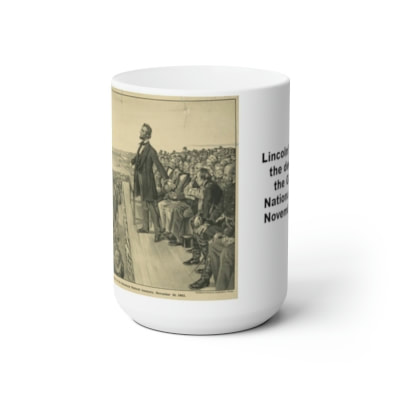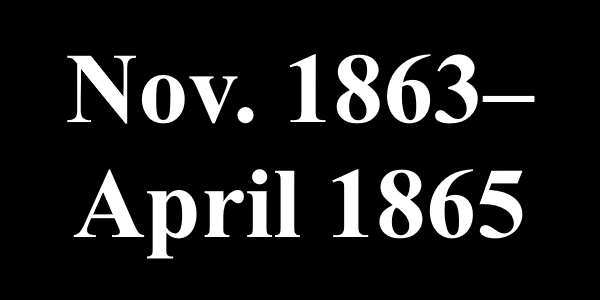Our MISSION: To provide accurate information regarding the Civil War timeline with Civil War dates, the Battle of Ft. Sumter and other Civil War battles all with a touch of Americana including Civil War History & memorabilia with quality products that inspire Civil War History buffs and lovers of Americana.
The Civil War Started on April 12, 1861 and the Civil War ended on April 9, 1865
Civil War Timeline continues:
November 1863–April 1865
On November 19, 1863, Abraham Lincoln offered “a few appropriate” remarks at the dedication of a cemetery to fallen Federal troops at Gettysburg. In his brief and eloquent “Gettysburg Address,” Lincoln articulated the purpose of the war and looked beyond it to a time when the nation would once again be made whole.
Yet even greater sacrifice lay ahead. In spring 1864, the Union and the Confederacy plunged into bloody campaigns that inaugurated a fourth year of fighting, prolonging and increasing the horrors of war. Casualty lists had grown to the hundreds of thousands. Civilians on both sides strained to help their governments cope with never-ending waves of the sick and wounded, as well as white and black refugees fleeing before armies or following in their wake. Throughout the year, the Union pursued a “hard war” policy, aimed at destroying all resources that could aid the Rebellion. But the South continued to fight; the end was not yet in sight.
The year 1865 opened with Union victories in the East that closed Lee’s most vital supply line. Further south, U.S. General William T. Sherman’s army stormed out of Georgia and through South Carolina, where Charleston fell in mid-February. By April, Sherman was pursuing Confederates under Joseph Johnston in North Carolina. Lee, unable to hold Petersburg or Richmond, evacuated those cities and was forced to surrender on April 9, 1865. With final victory in sight, Union luminaries gathered on April 14 for a special ceremony at Fort Sumter to again raise the Federal flag. Later that evening actor and Confederate sympathizer John Wilkes Booth assassinated President Abraham Lincoln at Ford’s Theatre in Washington, D.C.
November 1863–April 1865
On November 19, 1863, Abraham Lincoln offered “a few appropriate” remarks at the dedication of a cemetery to fallen Federal troops at Gettysburg. In his brief and eloquent “Gettysburg Address,” Lincoln articulated the purpose of the war and looked beyond it to a time when the nation would once again be made whole.
Yet even greater sacrifice lay ahead. In spring 1864, the Union and the Confederacy plunged into bloody campaigns that inaugurated a fourth year of fighting, prolonging and increasing the horrors of war. Casualty lists had grown to the hundreds of thousands. Civilians on both sides strained to help their governments cope with never-ending waves of the sick and wounded, as well as white and black refugees fleeing before armies or following in their wake. Throughout the year, the Union pursued a “hard war” policy, aimed at destroying all resources that could aid the Rebellion. But the South continued to fight; the end was not yet in sight.
The year 1865 opened with Union victories in the East that closed Lee’s most vital supply line. Further south, U.S. General William T. Sherman’s army stormed out of Georgia and through South Carolina, where Charleston fell in mid-February. By April, Sherman was pursuing Confederates under Joseph Johnston in North Carolina. Lee, unable to hold Petersburg or Richmond, evacuated those cities and was forced to surrender on April 9, 1865. With final victory in sight, Union luminaries gathered on April 14 for a special ceremony at Fort Sumter to again raise the Federal flag. Later that evening actor and Confederate sympathizer John Wilkes Booth assassinated President Abraham Lincoln at Ford’s Theatre in Washington, D.C.
This beautiful picture of the Gettysburg Address is available as wall art in several medias including acrylic art on a stand, metal wall art in various sizes, and as posters. The picture of Abe Lincoln giving the address is available in 11 oz ceramic mugs, 15 oz ceramic mugs, and as a premium poster. Astounding gifts when combined! Click on any of the images for more information. Please note, items will be shipped separately and our Christmas cut-off deadline in December 5. Only available to ship in the USA.
Something I didn't know until recently:
There were envelopes printed during the Civil War Battles with flags and figures from the Civil War. While the contents of those letters are long gone - my guess they told of love, lack of love, babies, gardens, the weather, and everything that was happening in those days when life was turned upside down for so many - the envelopes live on enamel camp mugs. We have a collection of 30 for your enjoyment. Some were rather faded but nonetheless, tell a tale worth seeing. You can see them and some other civil war mugs here.
There were envelopes printed during the Civil War Battles with flags and figures from the Civil War. While the contents of those letters are long gone - my guess they told of love, lack of love, babies, gardens, the weather, and everything that was happening in those days when life was turned upside down for so many - the envelopes live on enamel camp mugs. We have a collection of 30 for your enjoyment. Some were rather faded but nonetheless, tell a tale worth seeing. You can see them and some other civil war mugs here.














